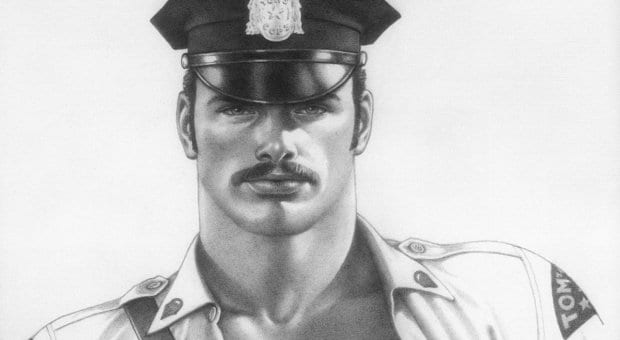Given the engorged state of my internet browser’s porn folders, it’s hard to imagine a time when sexy gay videos and images were hard to come by. But back in the 1950s and ’60s, many of our horny brethren resorted to perusing fitness magazines in order to view the male body au naturel, or as close as it could get without being censored.
These collections of photos and drawings can seem pretty tame by today’s standards; pencil drawings of hairy lumberjacks or flexing bodybuilders may not have screamed “gay” to the casual observer, but trailblazing artists like Touko Laaksonen managed to pack a whole lot of homoeroticism into their mesmerizing visuals.
It was all very much on the down-low, of course. Homosexual activities were conducted in secret, and even if these beefcake magazines were primarily aimed at the gay market, it was never openly acknowledged that they served any purpose other than as inspiration for the physically fit. Laaksonen’s illustrations were published simply under the name Tom of Finland and graced the cover of many such magazines. As laws and attitudes toward homosexuality loosened, Laaksonen’s work became more provocative, while still highlighting his own fetish for uniformed men and burly lumberjacks. Later artists like Etienne and Robert Mapplethorpe would credit these drawings as inspiration for their own sexually charged work.
Perhaps Laaksonen’s celebration of heightened masculinity provided marginally safe cover from a public whose views of gay men generally stopped at the effeminate sissies who worked as hairdressers or served as whipping posts for high-school jocks. His images are undeniably butch, reflecting the artist’s own agenda of reclaiming masculinity for gay men.
“He really just wanted to give back to us something that society was denying us,” says Durk Dehner, friend and business partner to Laaksonen. “We were being denied our masculinity. He wanted us to be fully male and fully gay — to celebrate both of those things within ourselves.”
Dehner is co-founder of the Tom of Finland Foundation, an organization dedicated to collecting, preserving and exhibiting homoerotic work. He worked closely with Laaksonen before the artist’s death in 1991 and still remains active in preserving the memory and importance of his friend’s work. Dehner is particularly excited about the upcoming collaboration with Helsinki-Filmi to produce a feature-length biopic about Laaksonen, announced at the 2013 Toronto International Film Festival. It’s the first time the foundation has authorized a film portrayal of the artist, but Dehner is reassured that Scandinavian director Dome Karukoski will do his friend’s life justice.
“I couldn’t be happier,” Dehner says. “I know that Helsinki-Filmi will make a film that is honourable and respectful to Tom’s legacy. It’s an important part of our history, and I believe it is in very good hands.”
For more information on the Tom of Finland Foundation, go to tomoffinlandfoundation.org.

 Why you can trust Xtra
Why you can trust Xtra


